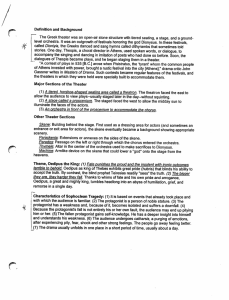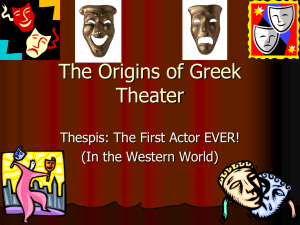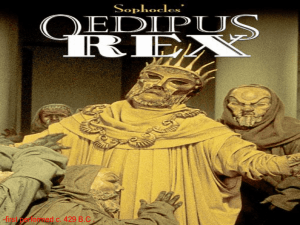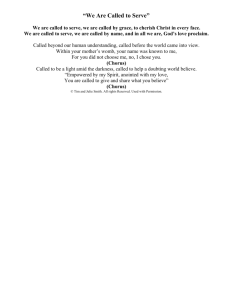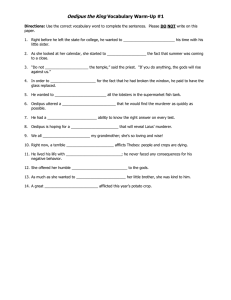Ancient Greek Theatre
advertisement
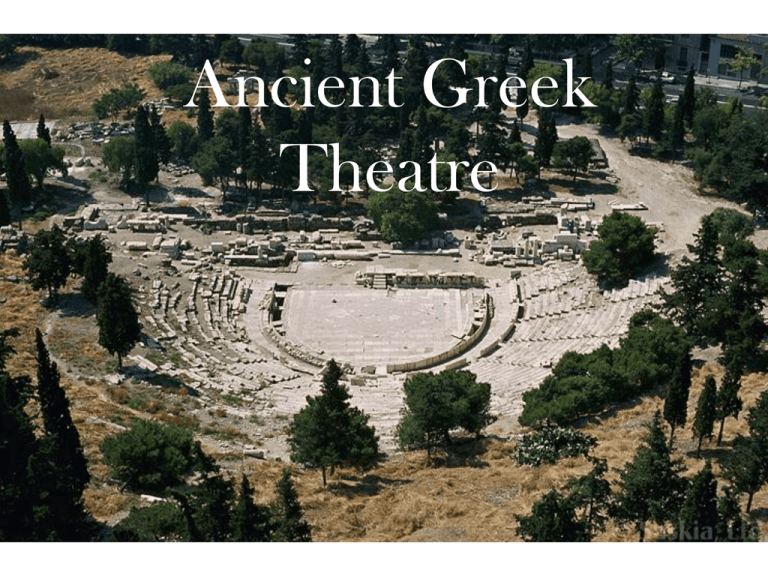
Ancient Greek Theatre Greek tragedies and comedies were always performed in outdoor theaters. Early Greek theaters were probably little more than open areas in city centers or next to hillsides where the audience, standing or sitting, could watch and listen to the chorus singing about the exploits of a god or hero. From the late 6th century BC to the 4th and 3rd centuries BC there was a gradual evolution towards more elaborate theater structures, but the basic layout of the Greek theater remained the same. The major components of Greek theater are labeled on the diagram above. • Orchestra: The orchestra (literally, "dancing space") was normally circular. It was a level space where the chorus would dance, sing, and interact with the actors who were on the stage near the skene. The earliest orchestras were simply made of hard earth, but in the Classical period some orchestras began to be paved with marble and other materials. In the center of the orchestra there was often a thymele, or altar. The orchestra of the theater of Dionysus in Athens was about 60 feet in diameter. • Theatron: The theatron (literally, "viewing-place") is where the spectators sat. The theatron was usually part of hillside overlooking the orchestra, and often wrapped around a large portion of the orchestra (see the diagram above). Spectators in the fifth century BC probably sat on cushions or boards, but by the fourth century the theatron of many Greek theaters had marble seats. • Skene: The skene (literally, "tent") was the building directly behind the stage. During the 5th century, the stage of the theater of Dionysus in Athens was probably raised only two or three steps above the level of the orchestra, and was perhaps 25 feet wide and 10 feet deep. The skene was directly in back of the stage, and was usually decorated as a palace, temple, or other building, depending on the needs of the play. It had at least one set of doors, and actors could make entrances and exits through them. There was also access to the roof of the skene from behind, so that actors playing gods and other characters (such as the Watchman at the beginning of Aeschylus' Agamemnon) could appear on the roof, if needed. • Parodos: The parodoi (literally, "passageways") are the paths by which the chorus and some actors (such as those representing messengers or people returning from abroad) made their entrances and exits. The audience also used them to enter and exit the theater before and after the performance. The basic structure of a Greek tragedy is fairly simple. After a prologue spoken by one or more characters, the chorus enters, singing and dancing. Scenes then alternate between spoken sections (dialogue between characters, and between characters and chorus) and sung sections (during which the chorus danced). Here are the basic parts of a Greek Tragedy: a. Prologue: Spoken by one or two characters before the chorus appears. The prologue usually gives the mythological background necessary for understanding the events of the play. b. Parodos: This is the song sung by the chorus as it first enters the orchestra and dances. c. First Episode: This is the first of many "episodes", when the characters and chorus talk. d. First Stasimon: At the end of each episode, the other characters usually leave the stage and the chorus dances and sings a stasimon, or choral ode. The ode usually reflects on the things said and done in the episodes, and puts it into some kind of larger mythological framework. For the rest of the play, there is alternation between episodes and stasima, until the final scene, called the... e. Exodos: At the end of play, the chorus exits singing a processional song which usually offers words of wisdom related to the actions and outcome of the play. List of Characters • • • • • • • • • Oedipus King of Thebes. As a young man, he saved the city of Thebes by solving the riddle of the Sphinx and destroying the monster. He now sets about finding the murderer of the former king Laius to save Thebes from plague. Creon The second-in-command in Thebes, brother-in-law of Oedipus. He is Oedipus’ trusted advisor, selected to go to the oracle at Delphi to seek the Apollo’s advice in saving the city from plague. Tiresias A blind prophet who has guided the kings of Thebes with his advice and counsel. Jocasta Queen of Thebes, wife of Oedipus. She was the widow of Thebes’ former king, Laius, and married Oedipus when he saved the city from the Sphinx. A Messenger from Corinth A man bringing news of the royal family to Oedipus. A Shepherd A herder from the nearby mountains, who once served in the house of Laius. A Messenger A man who comes from the palace to announce the death of the queen and the blinding of Oedipus. Antigone and Ismene Oedipus’ young daughters. Chorus A group of Theban elders, and their Leader (Choragus) , who comment on the events of the drama and react to its tragic progression.


